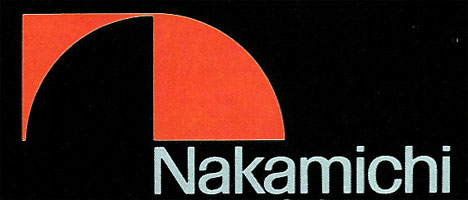Nakamichi was founded in 1948 as Nakamichi Research
Corporation Ltd (Nakamichi Kenkyujo Kabushiki Kaisha ) in Tokyo
Japan. It specialised in manufacturing portable radios, tone
arms, speakers, and communications equipment. Founded by Etsuro
Nakamichi, it was later headed by his younger brother Niro. Etsuro's
son Ted is the only remaining Nakamichi in the company today.
The company was originally established as a research and development
firm in electronics and optics but later became known as a manufacturer
of quality audio products. While their cassette decks were particularly
well known, the company is also credited with numerous other
audio innovations, such as self-centering record players, high-end
DAT recorders, and ultra-compact slot-loading CD changers. Over
the years, the company managed to garner an impressive level
of brand loyalty.
In the 1950s, Nakamichi developed one of the first
open reel tape recorders in Japan under the Magic Tone label.
In 1957 it developed and made its own magnetic tape heads. With
the advent of magnetic tape at the time, the company decided
to work with the format. Subsequently it went onto develop and
market its own tape recorder, and during that same year, launched
the Fidela 3-head Open Reel Stereo Tape Deck.
Because of its experience in manufacturing magnetic
tape heads and equipment, in 1967 the company started making
tape decks for a number of foreign manufacturers including Harman
Kardon, KLH, Advent, Fisher, ELAC, Sylvania, Concord, Ampex and
Motorola.
In 1973 Nakamichi created stereo cassette decks with
such high quality that eventually made reel-to-reel tape recorders
obsolete for consumers. The Nakamichi 1000 and 700 were regarded
as two of the finest cassette recorders made in the mid-1970s.
They had three heads, dual capstan drive that reduced wow and
flutter to new low levels, and Dolby-B noise reduction to improve
the signal to noise ratio. The feature that really set them apart
was the adjustable record head azimuth and Dolby calibration
that could be optimized for each cassette tape. Many audiophiles
aspired to but could not afford a Nakamichi 1000 or 700 (whose
model number was derived from the list price), so Nakamichi came
out with more economical two-head models such as the Nakamichi
500 and the wedge-shaped 600.
Nakamichi pushed live recording with their Nakamichi
550, a portable cassette recorder that had three microphone inputs:
one for left channel, one for right channel, and one for a center
blend channel. This recorder could run from batteries or AC and
was used to make very high quality recordings in the field. All
of these products were known for top-notch engineering and sound
quality.
In the late 1970s Nakamichi updated their machines
with the Nakamichi 1000 II, the 700 II, and other midrange and
low-end models. They branched out into other audio components
such as amplifiers and eventually speakers, but these products
were never as highly regarded by the audio community as their
cassette decks.
In the early 1980s Nakamichi came out with further
refinements in a successor top-of-the-line machine, the Nakamichi
1000ZXL. Prices pushed upward with this machine being $3,800
at the time. The updated 700ZXL was a mere $3,000. Low-end cassette
decks sold new for under $200, with the Nakamichi name on them.
This time period stands as the pinnacle for cassette recorders,
as from that time onwards digital recording methods began to
make inroads.
Nakamichi has never held its prominent position in
audio technology since that time. Although the company dabbled
with a 6 disc CD changer for use in computers in the late 1990s
they failed to move quickly to the rapidly expanding computers
market compared to other Japanese electronics companies such
as Sony, Toshiba and Yamaha who introduced single disc CD ROM
drives. The company tried to promote DAT and CDs (they launched
the OMS-70 CD player in 1984) but their core engineering expertise
remained with cassette based technologies. With the decline of
analog taping, Nakamichi was unable to retain its appeal to the
high end audio community.
By the end of 1990s Nakamichi was largely forgotten.
It was acquired by the Grande Holdings, but was allowed to be
run independently and with mostly the original management and
design teams. Niro Nakamichi left in 1998 to set up Mechanical
Research Corporation. The company went into bankruptcy protection
on February 19, 2002.
The company emerged from bankruptcy and repositioned
itself as a manufacturer of high-end "lifestyle" systems"
a la Bang & Olufsen. They also manufacture a range of CD
changers available for Hi-fi, computer, and car audio use.
As of June 2006, Nakamichi released its first portable
DVD player with built-in LCD screen, the Lumos
Thanks to Wikipedia
|





